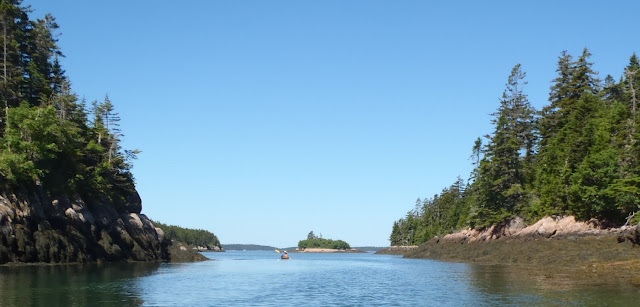Basics: Launch Merepoint Neck; fairly empty when we paddled but with signs implying it is jammed and busy. Two outhouses, No Overnight Parking.
Trip 2: Out via Birch and the Gooses, in via Bustins, Williams etc 9.3 miles, launch 8, finish 11:45, 30 minute break. High about 1PM. (This was the second half of our trip south to Bath. After an overnight stay, at the elegant
Parkwood Inn, we wanted to paddle on more open salt water. )
Casco Bay is noted for its fingerlike extensions, dripping out to sea. On this trip I hoped to explore coves and islands and perhaps enjoy increasing swell as we worked our way west.
 |
| Typical view from the islands of Casco Bay |
I planned our paddle from the public launch at Merepoint Neck because not only did the
MITA guidebook state it was an all tide ramp, but also it did not caution that parking was extremely limited. However, everything at the launch implies it gets very busy. There are signs limiting time on the ramp to 30 minutes, prior to arriving at the ramp there are pull-outs in which to ready your boat. Another sign cautions boaters to form two lines and to wait until their side of the ramp is free to launch. Hand-carry boats are given a second pull-out area near the top of the ramp, presumably we should carry the boats down from there. We’d brought along
our carts and just towed the boats from where we parked. And on the evening of Jun 30 and the morning of July 1, the area was pretty quiet.
As we went to launch in the morning we noted another sign, this one cautioning us of airboats in the area. And sure enough an airboat soon pulled up to the ramp. We had a pleasant talk with the friendly outgoing men waiting on the boat for their trailer to pull down. They were clammers, and loved the access of the boats to clam flats. When we mentioned bottoming out while crossing between Birch and White, they laughed and said they didn’t even need water to make it through there.
Another difference between Casco and Penobscot Bay was in the lobster buoys, long handled buoys seemed the norm on these waters.
Despite the many boats moored in the bay, most of our crossings had little traffic. We crossed over to Birch, and glided along the turn of the century cottages, then paddled along the eastern edge of Upper and Lower Goose. We spent some time on a MITA island, admiring the rocks and shells.
 |
| Interesting granite |
 |
| View out to sea |
 |
| Shore full of periwinkles and whelks |
By the time we were ready to leave, another group had arrived and, like us, they were amazed that on this gorgeous bright day before the Fourth of July weekend the bay was so quiet.
From the Gooses we passed to Bustin, home of one of my favorite cottages, this delightful octagon house perched on an outcropping. It shows on the chart as a circle labeled “house” just off shore in the blue.
From Bustins it was back along four smaller islands to the landing. The seas were quiet, and the wind negligible along the trip, making these waters calmer than the Kennebec had been the day before.
Trip 1: An evening paddle out to Birch and attempting to pass through to Little Birch, along White and back to the launch. Launch 4.45PM, low 6PM, finish 6PM 3.8 miles.
After our paddle on the Kennebec River we checked into the
Parkwood Inn, reveling in their showers before heading out to the
Flip Side for some incredible pizza, then, because I like paddling at low tide, we headed to the Merepoint Landing. Knowing we were headed out to the Goose Islands in the morning, for this evening paddle we planned to either putter along the interior harbor, or circumnavigate Birch.
We easily made it to Birch and it looked like we’d make it between Birch and White to Little Birch. But about halfway through the green area on the chart (which is above water at low tide) we began bottoming out. Mark tested the bottom and discovering it was muddy, chose to quickly head back the way we came rather than wading through. We were just a little too late, perhaps if we’d skipped the second slice of pizza, or hadn’t wandered through the Tontine Mall trying to discover why a fiberglass kayak was mounted outside we would have made it.
Marshy low water was pretty much the story after we left White Island heading back to Merepoint Neck. The water was shallow and weedy, with not much on the bottom worth viewing.
There are dozens of boats moored off Merepoint Neck, including this lovely wooden cruiser.
It was a pretty paddle, and very mellow, the wind had dropped off, the sky was mostly gray and quite peaceful, but as low tide paddles go it was pretty bland; no starfish, no sea urchins, no sand dollars.
At the hotel I found a Pamplet called
Coastal Harpswell Maine listing several more launch points, but no details about access, parking etc. See also harpswellmaine.org
 |
| A long way up the ramp at low tide |













































